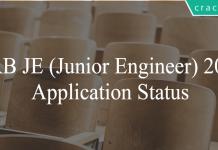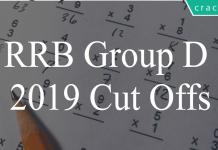Number System Questions for RRB NTPC Set-3 PDF
Download RRB NTPC Number System Questions and Answers set-3 PDF. Top 15 RRB NTPC Number System questions based on asked questions in previous exam papers very important for the Railway NTPC exam.
Download Number System Questions for RRB NTPC Set-3 PDF
Take a free mock test for RRB NTPC
Download RRB NTPC Previous Papers PDF
Question 1: Find the greatest number that divides 82, 147 and 199 so as to leave the same remainder in each case.
a) 7
b) 11
c) 13
d) 17
Question 2: If on subtracting 32 from a number, the remainder will be 2/3rd of the number, what will be 25% of the number?
a) 24
b) 48
c) 72
d) 96
Question 3: If one-sixth of $\frac{3}{8}$ of $\frac{2}{5}$ of a number is equal to 96 then what will be 10% of the number?
a) 284
b) 384
c) 484
d) 684
Question 4: Sum of three numbers is 120 and the ratio of first and second number is equal to 4:5. Ratio of second number to third number is 15:13. What is the third number?
a) 36
b) 45
c) 39
d) 38
Question 5: If the sum of the digits of a number is 8 and difference of the digits is 2 then what will be the product of the digits of the number?
a) 12
b) 15
c) 20
d) 24
RRB NTPC Previous Papers [Download PDF]
Question 6: The difference between a two digit number and the number obtained by interchanging its digit is 54. What is the difference between the digits of the number?
a) 5
b) 4
c) 7
d) 6
Question 7: Find the smallest positive number which on division by 2,7,3 leaves remainder 1,6,2 respectively in each case.
a) 42
b) 41
c) 83
d) 82
Question 8: Find the 3rd smallest positive number which on division by 2,7,5 leaves remainder 1 in each case?
a) 71
b) 1
c) 211
d) 141
Question 9: If the number on division by 3, 5, 6 and 8 leaves the remainder 1, 3, 4, 6 respectively, then find the 2nd smallest positive number of such a series?
a) 358
b) 235
c) 238
d) 240
Question 10: A number on division by 5,7,10,12 gives remainder 3 in each case. Find the 5th smallest positive number of such a series.
a) 1683
b) 2103
c) 1263
d) 2523
Question 11: If the number 9a53b25 is divisible by 99, then find the value of a and b respectively.
a) 2,1
b) 3,0
c) 1,2
d) 0,1
Question 12: Find the second smallest positive number which when divided by 5,7,9 leaves remainder 3 in each case?
a) 3
b) 315
c) 317
d) 318
Question 13: What is the HCF of the numbers 8, 20, 24 and 36?
a) 4
b) 8
c) 12
d) 16
Question 14: Which of the following is not a prime number?
a) 167
b) 313
c) 509
d) 1001
Question 15: Find the digit in the ten’s place of $19^2+21^2$.
a) 0
b) 2
c) 4
d) 6
Download General Science Notes PDF
Answers & Solutions:
1) Answer (C)
147 – 82 = 65
199 – 147 = 52
The HCF of these differences is the number that divides all the three numbers leaving the same remainder.
65 = 13 * 5
52 = 13 * 4
=> HCF = 13
Hence, 13 is the answer.
2) Answer (A)
Let’s say number is x
Hence, x-32 = 2x/3
Or x = 96
So 25% of the number will be 24
3) Answer (B)
Let’s say number is x then $x \times\frac{1}{6} \times \frac{3}{8} \times \frac{2}{5} = 96$
Hence, after solving the above equation we will get x = 3840
So 10% of the number will be 384
4) Answer (C)
The ratio of the first two numbers is 4:5 which equals 12:15
Hence, the ratio of all three numbers will be = 12:15:13
And let’s say numbers are 12x, 15x and 13x
So the summation of the numbers = 40x = 120
Or x= 3
Hence, numbers are 36, 45 and 39
5) Answer (B)
Let’s say number is 10x+y (Where digits of the number will be x and y)
x-y = 2
x+y = 8
Hence, x = 5 and y = 3
Product of the digits will be = 15
RRB NTPC Previous Papers (Download PDF)
6) Answer (D)
Let’s say number is 10x+y. Hence, after interchanging their digits, new number will be 10y+x. So difference will be 9(x-y) = 54
Difference between the digits will be x-y = 6
7) Answer (B)
This number can be expresssed in the form = LCM(2,7,3)k-1 = 42k-1. The smallest number is 42*1-1 = 41
8) Answer (D)
The number is of the form LCM(2,7,5)k+1 = 70k+1. The numbers are 1,71,141 and so on. The 3rd smallest number is 141.
9) Answer (C)
In this case the difference between the divisor and the remainder is constant in each case = 3-1 = 2, 5-3 = 2, 6-4 = 2 and 8-6 = 2.
The number would be of the form LCM (3, 5, 6, 8) k – 2 = 120 k – 2
The second smallest positive number would be 120*2 – 2 = 238.
10) Answer (A)
As mentioned in the concept, the number would be of the form LCM (5, 7, 10, 12) k + 3 = 420 k + 3.
The smallest term is 3. The second smallest term is (420*1)+3 = 423.
The 5th smallest term is (420*4) + 3 = 1680+3 = 1683.
11) Answer (B)
Since the number is divisible by 99, the number is divisible by 9 and 11 as 99 = 9*11
9+a+5+3+b+2+5 should be divisible by 9
24+a+b should be divisible by 9.
24+a+b = 27 or 36
a + b = 3 or 12
Similarly (9+5+b+5)-(a+3+2) = 14+b-a should be divisible by 11
14+b-a = 11 or 22
a – b = 3 or -8
When a + b = 12 and a – b = 3, then a = 7.5 which is not possible
When a + b = 12 and a – b = -8, then a = 10 which is not possible
When a + b = 3 and a – b = -8, then a = -2.5 which is not possible
When a + b = 3 and a – b = 3, then a = 3 and b = 0 which is the solution.
12) Answer (D)
The number is of the form LCM(5,7,9)k+3 = 315k+3 = 318.
13) Answer (A)
$8 = 2^3$
$20 = 2^2 * 5$
$24 = 2^3 * 3$
$36 = 2^2 * 3^2$
So, the HCF of the four numbers is $2^2$ = 4
14) Answer (D)
1001 = 7*11*13
=> 1001 is not prime
15) Answer (A)
$19^{2}+21^{2}$
= 361 + 441
= 802
=> Ten’s digit is 0.
DOWNLOAD APP FOR RRB FREE MOCKS
We hope this Number System Questions set-3 pdf for RRB NTPC Exam will be highly useful for your Preparation.





